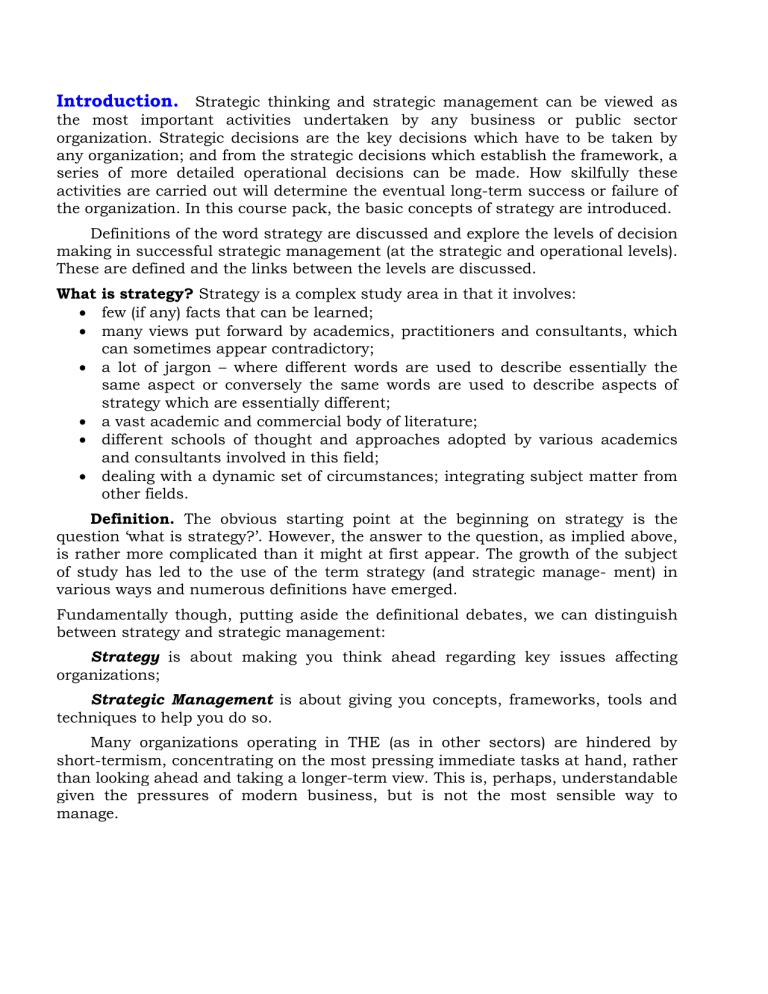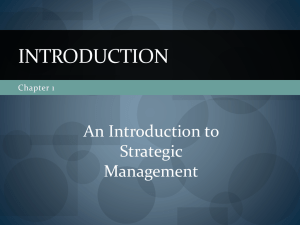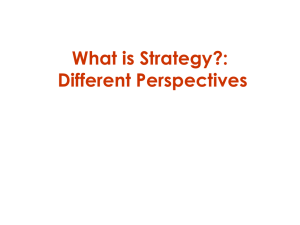
Introduction. Strategic thinking and strategic management can be viewed as the most important activities undertaken by any business or public sector organization. Strategic decisions are the key decisions which have to be taken by any organization; and from the strategic decisions which establish the framework, a series of more detailed operational decisions can be made. How skilfully these activities are carried out will determine the eventual long-term success or failure of the organization. In this course pack, the basic concepts of strategy are introduced. Definitions of the word strategy are discussed and explore the levels of decision making in successful strategic management (at the strategic and operational levels). These are defined and the links between the levels are discussed. What is strategy? Strategy is a complex study area in that it involves: few (if any) facts that can be learned; many views put forward by academics, practitioners and consultants, which can sometimes appear contradictory; a lot of jargon – where different words are used to describe essentially the same aspect or conversely the same words are used to describe aspects of strategy which are essentially different; a vast academic and commercial body of literature; different schools of thought and approaches adopted by various academics and consultants involved in this field; dealing with a dynamic set of circumstances; integrating subject matter from other fields. Definition. The obvious starting point at the beginning on strategy is the question ‘what is strategy?’. However, the answer to the question, as implied above, is rather more complicated than it might at first appear. The growth of the subject of study has led to the use of the term strategy (and strategic manage- ment) in various ways and numerous definitions have emerged. Fundamentally though, putting aside the definitional debates, we can distinguish between strategy and strategic management: Strategy is about making you think ahead regarding key issues affecting organizations; Strategic Management is about giving you concepts, frameworks, tools and techniques to help you do so. Many organizations operating in THE (as in other sectors) are hindered by short-termism, concentrating on the most pressing immediate tasks at hand, rather than looking ahead and taking a longer-term view. This is, perhaps, understandable given the pressures of modern business, but is not the most sensible way to manage. It is extremely difficult for organizations to plan ahead, in the same way as it is difficult to forecast the weather or foresee future interest rate movements, because there are so many aspects of uncertainty and change. In order to facilitate the process of strategic management, concepts, frameworks, tools and techniques have been developed. The overall aim of strategic management is thus to develop a framework for thinking ahead – for planning strategically. Chandler’s definition. A number of writers have tried to sum up the meaning of strategy succinctly to make it easier for students to understand. One such definition, which despite its age is still widely quoted and adapted, was offered by Professor Chandler of Harvard Business School in 1962. The elements of strategy. This definition clearly shows the three elements (or components) of strategy. The definition above emphasizes long-term goals; actions to achieve the goals and allocation of resources: The determination of the basic long-term goals and objectives concerns the conceptualization of coherent and attainable strategic objectives. Without objectives, nothing else can happen. If you do not know where you want to go, how can you act in such a way as to get there? The adoption of courses of action refers to the actions taken to arrive at the objectives that have been previously set. The allocation of resources refers to the fact that there is likely to be a cost associated with the actions required in order to achieve the objectives. If the course of action is not supported with adequate levels of resource, then the objective will not be accomplished. The short case illustration below uses the analogy of a journey to illustrate the three elements of Chandler’s definition of strategy. Short Case Illustration 1 A journey from Berlin to Paris. By way of analogy we can consider a journey, say from Berlin to Paris. Your objective is clear: to arrive in Paris, travelling from Berlin. However, in making this journey there are various courses of action available to you. You might travel by train, by car, by coach or by plane. You might travel on certain days or at certain times of day. You might take advantage of certain concessionary fares and you might make a booking through an intermediary such as a travel agent, internet search site such as Expedia or book directly with the principal company (the airline or train company) Thus as a result of wanting to travel to Paris from Berlin, a whole range of options need to be considered and detailed decisions have to be taken as to which options to select. Hence strategy contains three elements: 1. Your objective is clearly stated as arriving in Paris at a certain date and time. 2. In order to achieve this objective certain actions are necessary which are chosen from a range of alternative options available. If might be decided that flying is the best option. Therefore, a specified flight is booked through a travel agent and a plane is boarded at the airport. 3. However, the actions could not be achieved if they could not be resourced. You need the resources of a plane with a suitably qualified pilot, an airport, money to pay for your flight and other such ‘inputs’. If any one of these is missing, you will be unable to meet your objective. The practice of strategy. The number and range of academics, consultants, authors and practitioners claiming to be involved in strategy in some way is vast. Given this diversity, it is unsurprising that, notwithstanding how we might formally define the term strategy, in practice the term has been used in numerous ways. It was this multiplicity of uses of the term that led Professor Henry Mintzberg of McGill University in Montreal, Canada, originally writing in the late 1980s (Mintzberg, 2002: 3–9), to propose his ‘five Ps’ of strategy. Mintzberg’s five Ps. Mintzberg suggested that nobody can claim to own the word ‘strategy’ and that the term can legitimately be used in several ways. A strategy can be: ● a plan; ● a ploy; ● a pattern of behaviour; ● a position in respect to others; ● perspective. Note: It is important not to see each of these five Ps in isolation from each other. One of the problems of dividing ideas into frameworks, like the five Ps, is that they are necessarily simplified. The five Ps are not mutually exclusive, i.e. it is possible for an organization to show evidence of more than one interpretation of strategy Plan strategies. A plan is probably the way in which most people use the word strategy. It tends to imply something that is intentionally put in place and its progress is monitored from the start to a predetermined finish. Some business strategies follow this model. ‘Planners’ tend to produce internal documents that detail what the company will do for a period of time in the future (say five years). It might include a statement on the overall direction that the organization will take in seeking new business opportunities as well as a schedule for new product launches, acquisitions, financing (i.e. raising money), human resource changes, marketing, etc. Ploy strategies. A ploy is generally taken to mean a short-term strategy, and is concerned with the detailed tactical actions that will be taken. It tends to have very limited objectives and it may be subject to change at very short notice. Mintzberg describes a ploy as ‘a manoeuvre intended to outwit an opponent or competitor’. He points out that some companies may use ploy strategies as threats. They may threaten to, say, decrease the price of their products simply to destabilize competitors. Pattern strategies. A ‘pattern of behaviour’ strategy is one in which progress is made by adopting a consistent form of behaviour. Unlike plans and ploys, patterns ‘just happen’ as a result of the consistent behaviour. Short Case Illustration 2. Plan, ploy and pattern strategies: a Northern European tour operator A large tour operator which operates to various Mediterranean destinations offering holidays mainly to Northern Europeans might operate plan, ploy and pattern strategies in various parts of its business. ● Plan – A large tour operator, for instance, might decide that it plans to implement a strategy concerned with expanding its share of the market and that this will be achieved by setting prices at lower levels than competitors and by acquiring smaller firms. ● Ploy – Whilst the tour operator concerned has an overall strategy which it has planned that includes offering lower price levels than competitors, it might also develop a short-term ploy. The company might suddenly discount its prices within six weeks of customers’ departure in order to destabilize its competitors and to sell excess capacity. ● Pattern – In keeping with the consolidation that has taken place in the industry the tour operator concerned in this illustration might have acquired a small specialist operation offering summer villa and apartment holidays to a particular Greek island to a small but loyal group of customers. This might be viewed as following a pattern strategy. The company is unlikely to produce elaborate plans, simply renewing contracts with property owners and transport providers annually. If offered a new villa on favourable terms, then the operator would probably contract the property and feature it on its website without thinking about it. It is an opportunity that is taken, as it appears too good to miss. However, the tour operator would probably not feature a hotel in Majorca, although it may be available to the company, because that would be outside their pattern of business behaviour. Such patterns of behaviour are sometimes unconscious, meaning that they do not even realize that they are following a consistent pattern. Nevertheless, if it proves successful, it is said that the consistent behaviour has emerged into a success. This is in direct contrast to planning behaviour. Position strategies. A position strategy is appropriate when the most important issue to an organization is perceived to be how it relates or is positioned in respect to its competitors or its markets (i.e. its customers). In other words, the organization wishes to achieve or defend a certain position. In business, companies tend to seek objectives such as market share, profitability, superior research, reputation, etc. It is plainly obvious that not all companies are equal when such criteria are considered. Perspective strategies. Perspective strategies are about changing the culture (the beliefs and the ‘feel’; the way of looking at the world) of a certain group of people – usually the members of the organization itself. Some companies want to make their employees think in a certain way, believing this to be an important way of achieving success. They may, for example, try to get all employees to think and act courteously, professionally or helpfully. Short Case Illustration 3. Position and perspective strategies: hotels and airlines Many THE (Tourism, Hospitality and Events) companies such as international airlines or hotel operators have enviable reputations for reliability and quality whilst others are not so fortunate. ● Position – The competitors with a reputation to defend will use a position strategy to ensure that the reputation they enjoy is maintained and strengthened. This may include advertising and public relations activities, but it may also include a focus on other activities such as improving or adding product features, or pricing incentives. Marketing messages may even extend to pointing out the deficiencies in competitors’ products whilst pointing out the positive features of their own international hotel groups and some airlines have also developed a number of sub-brands in order to ensure that they are able to have a position they can defend in every segment of the market. ● Perspective – This view of strategy is often of central importance to many THE companies since they rely on delivering services of consistent quality. In THE the quality of service delivery is of- ten judged by the quality and attitude of those members of staff that are involved with delivering services. Consequently many THE companies invest heavily in developing a strong organizational culture which focuses greatly on the attitude of employees and their quality. Many large hotel groups and airlines, for example, go further and feature such a culture as a core strength. Employees (usually smiling!) are frequently featured in their advertising and other promotional activities since it is the quality of their encounter with customers which is seen as being the key factor in achieving high degrees of customer satisfaction. SELF-SUPPORT: You can click the URL Search Indicator below to help you further understand the lessons. Search Indicator References: Evans, N., (2015) Strategic Management for Tourism, Hospitality and Events Second Edition Routledge 2 Park Square, Milton Park, Abingdon, Oxon OX14 4RN. ISBN: 978-0-203-77149-5 (ebk) Activity 1. Let us try to check your understanding of the topics. Write your answers to the space provided below every after the questions. 1. What are Mintzberg’s five Ps of strategy? ___________________________________________________________________________________ ___________________________________________________________________________________ __________________________________________________________________________________ 2. What are the three components of strategy as described by Chandler? ___________________________________________________________________________________ ___________________________________________________________________________________ __________________________________________________________________________________ Consider other T.H.E. situations you are familiar with and provide an example of 1. a plan strategy; 2. a ploy strategy; 3. a pattern strategy.



